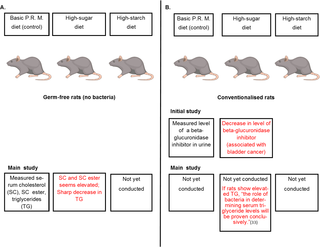PLOS Biology ( IF 9.8 ) Pub Date : 2017-11-21 , DOI: 10.1371/journal.pbio.2003460 Cristin E Kearns 1, 2 , Dorie Apollonio 1, 3, 4, 5 , Stanton A Glantz 1, 3, 5, 6, 7

|
In 1965, the Sugar Research Foundation (SRF) secretly funded a review in the New England Journal of Medicine that discounted evidence linking sucrose consumption to blood lipid levels and hence coronary heart disease (CHD). SRF subsequently funded animal research to evaluate sucrose’s CHD risks. The objective of this study was to examine the planning, funding, and internal evaluation of an SRF-funded research project titled “Project 259: Dietary Carbohydrate and Blood Lipids in Germ-Free Rats,” led by Dr. W.F.R. Pover at the University of Birmingham, Birmingham, United Kingdom, between 1967 and 1971. A narrative case study method was used to assess SRF Project 259 from 1967 to 1971 based on sugar industry internal documents. Project 259 found a statistically significant decrease in serum triglycerides in germ-free rats fed a high sugar diet compared to conventional rats fed a basic PRM diet (a pelleted diet containing cereal meals, soybean meals, whitefish meal, and dried yeast, fortified with a balanced vitamin supplement and trace element mixture). The results suggested to SRF that gut microbiota have a causal role in carbohydrate-induced hypertriglyceridemia. A study comparing conventional rats fed a high-sugar diet to those fed a high-starch diet suggested that sucrose consumption might be associated with elevated levels of beta-glucuronidase, an enzyme previously associated with bladder cancer in humans. SRF terminated Project 259 without publishing the results. The sugar industry did not disclose evidence of harm from animal studies that would have (1) strengthened the case that the CHD risk of sucrose is greater than starch and (2) caused sucrose to be scrutinized as a potential carcinogen. The influence of the gut microbiota in the differential effects of sucrose and starch on blood lipids, as well as the influence of carbohydrate quality on beta-glucuronidase and cancer activity, deserve further scrutiny.
中文翻译:

制糖业赞助的无菌啮齿动物研究将蔗糖与高脂血症和癌症联系起来:内部文件的历史分析
1965 年,糖研究基金会 (SRF) 秘密资助了《新英格兰医学杂志》上的一篇评论,该评论驳斥了蔗糖摄入量与血脂水平以及冠心病 (CHD) 相关的证据。SRF 随后资助了动物研究,以评估蔗糖的冠心病风险。本研究的目的是检查由 SRF 资助的一项名为“项目 259:无菌大鼠的膳食碳水化合物和血脂”的研究项目的规划、资金和内部评估,该项目由英国大学的 WFR Pover 博士领导。伯明翰,英国伯明翰,1967 年至 1971 年间。根据制糖业内部文件,采用叙述性案例研究方法评估 1967 年至 1971 年的 SRF 项目 259。259 项目发现,与饲喂基本 PRM 饮食(含有谷物粉、豆粕、白鱼粉和干酵母的颗粒饲料,并用均衡补充维生素和微量元素混合物)。SRF 的研究结果表明,肠道微生物群在碳水化合物引起的高甘油三酯血症中具有因果作用。一项对喂食高糖饮食的传统老鼠和喂食高淀粉饮食的老鼠进行比较的研究表明,蔗糖的摄入可能与β-葡萄糖醛酸酶水平升高有关,这种酶以前与人类膀胱癌有关。SRF 终止了 259 项目,但没有公布结果。制糖业没有披露动物研究的危害证据,这些证据会(1)强化蔗糖患冠心病的风险大于淀粉的论点,(2)导致蔗糖作为潜在致癌物受到审查。肠道微生物群对蔗糖和淀粉对血脂的不同影响的影响,以及碳水化合物质量对β-葡萄糖醛酸酶和癌症活性的影响,值得进一步研究。



























 京公网安备 11010802027423号
京公网安备 11010802027423号